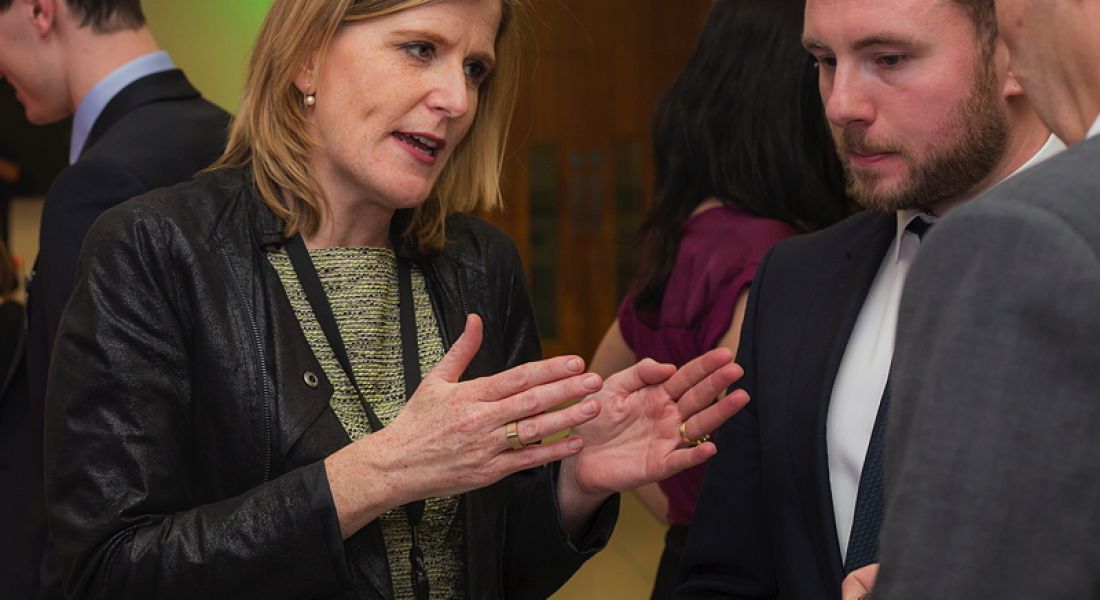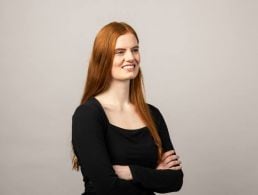Accenture Ireland has been working to make women more visible in its innovation and leadership campaigns.
When Eithne Harley got involved with Accenture Ireland’s Leaders of Tomorrow Award last year, she soon spotted an issue.
The annual competition seeks final-year third-level students and recent graduates with great ideas. But, in last year’s competition, all of the finalists pitching their ideas to a panel of judges were men.
“It was an aha moment,” recalls Harley, who is director of integrated marketing at Accenture Ireland. “So we said, for this year’s programme, one of our key objectives was to find the female applicants.”
That decision paid off: thanks to a conscious effort to make the campaign more inclusive, applications from women increased 70 per cent, and, tomorrow (2 March), two of the six ideas in the Leaders of Tomorrow finals will be pitched by women.
Leaders of Tomorrow
Now in its ninth year, the Leaders of Tomorrow programme was set up to foster innovation and to support the leaders of tomorrow, explains Harley, who became the initiative’s business sponsor last year. “It has become almost like a mini-student start-up programme,” she explains.
Each year, Accenture goes out to third-level campuses and looks for ideas to bring through the programme. So, from day one of the campaign this year, Harley and her team kept female inclusion and participation in mind.
“We were ruthless in our consciousness in our marketing,” she explains. “We had women in our campaign posters, we had a gender balance in the Accenture ambassadors and we [linked in] with women’s entrepreneurship initiatives that were going on campus.”
Accenture also hosted an event to showcase women in the start-up world and tapped into “sympathetic ambassadors in the community” to spread the word – for example by asking them to tweet about the campaign, explains Harley. “There are a lot of people out there – men and women – who want to advance this issue, so connecting to influencers is a good strategy.”
Female finalists
Harley stresses that there were no quotas, and that women who applied for and developed their ideas through the programme were there on merit alone. And, tomorrow, three of those women will be presenting ideas to a panel of judges.
Daryl O’Regan, who is studying IT and business at Dublin Institute of Technology, has brought an idea called Pitchit through the Leaders of Tomorrow competition.
The Pitchit platform allows job applicants to post videos and it helps potential employers to assess ‘soft’ skills that can be difficult to gauge from a CV, explains Harley. “It is hugely important in this digital age, where these skills are a key differentiator for people, so [Daryl] has put together an interesting video platform where people can apply for roles through video.”
Naomi Murphy and Marisa Denker are competing with their social enterprise initiative, Connect the Dots, which started out bringing people together around the issue of vacant space in Dublin, and has now expanded to reimagine networking events and conferences to better build community, unleash initiatives, and solve problems.
The overall winners will not only earn a place on the NDRC’s LaunchPad accelerator programme, they will also have the option of an internship with Accenture and to visit an international Accenture innovation and technology lab.
Relentless visibility
Harley says the steps to greater female inclusion were not complex, but that it was important to keep them in mind throughout. “That gender representation quality needs to be relentless,” she says.
Harley is also organising Accenture’s International Women’s Day event in Dublin next week, which Siliconrepublic.com will be attending, where details of another project to improve the visibility of women innovators will be detailed.
In partnership with the Royal Irish Academy, Accenture Ireland is running Women on Walls, a project that will see portraits of the first four women members admitted to the RIA in 1949 – Sheila Tinny, Francoise Henry, Phyllis Clinch and Eleanor Knott – and of contemporary female researchers gracing the walls of the Academy.
Pictured at the launch of Women on Walls are: Prof Aoife McLysaght, TCD; Alastair Blair, country managing director, Accenture Ireland; Laura Mahoney, CEO, Royal Irish Academy and Prof Lydia Lynch. Aoife’s and Lydia’s portraits will be amongst those hung on the walls of the Royal Irish Academy. Image via Accenture
The idea was sparked when Harley attended a meeting at the RIA and, during the tour afterwards, noticed all the male faces in the picture frames.
“I was looking up in a room that is like an art gallery with all these Victorian men looking down at me and I had an aha moment,” she says.
The Women on Walls project aims not only to build a cultural legacy but also to inspire greater visibility of women on walls around the world, notes Harley, who is a fan of the saying that ‘you can’t be what you can’t see’.
“It is a lovely programme that knits together something significant and we think it will be disruptive,” she says. “We would love to inspire others to put more women’s portraits on the walls in schools and other institutions around the world too.”
Women Invent is Silicon Republic’s campaign to champion the role of women in science, technology, engineering and maths. It has been running since March 2013, and is kindly supported by Intel, Open Eir (formerly Eircom Wholesale), Fidelity Investments, Accenture and CoderDojo.
Updated 9.50am, 2 March 2016: This article was updated to update the description of Connect the Dot’s business model.




